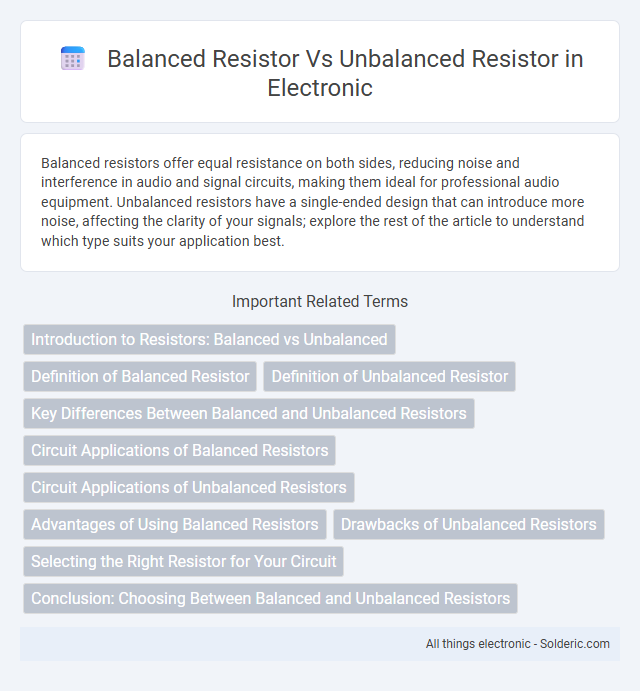Balanced resistors offer equal resistance on both sides, reducing noise and interference in audio and signal circuits, making them ideal for professional audio equipment. Unbalanced resistors have a single-ended design that can introduce more noise, affecting the clarity of your signals; explore the rest of the article to understand which type suits your application best.
Comparison Table
| Feature | Balanced Resistor | Unbalanced Resistor |
|---|---|---|
| Configuration | Two equal resistors in a symmetrical layout | Single resistor or asymmetrical setup |
| Signal Handling | Processes differential signals | Processes single-ended signals |
| Noise Rejection | High common-mode noise rejection | Low noise rejection, susceptible to interference |
| Impedance | Balanced impedance for both signal lines | Unbalanced impedance, reference to ground |
| Applications | Audio equipment, differential amplifiers, communication systems | Basic circuits, single-ended inputs |
| Complexity | More complex design | Simpler design |
| Cost | Generally higher due to precision resistors | Lower cost |
Introduction to Resistors: Balanced vs Unbalanced
Balanced resistors maintain equal impedance on both signal lines, minimizing noise and interference in audio and communication systems. Unbalanced resistors, by contrast, connect only one signal line to ground, making them more susceptible to external noise and signal degradation. Understanding these differences is crucial for optimizing circuit performance in sensitive applications like professional audio equipment or RF communication.
Definition of Balanced Resistor
A balanced resistor is designed with equal resistance values on both sides of a central reference point, ensuring symmetrical electrical characteristics in differential circuits. This symmetry reduces noise and interference, improving signal integrity in audio and communication applications. Unlike unbalanced resistors, which have a single-ended configuration, balanced resistors maintain equal impedance paths for both positive and negative signal lines.
Definition of Unbalanced Resistor
An unbalanced resistor is an electrical component with unequal resistance values or configurations across different branches of a circuit, causing asymmetrical current flow. It is typically used in single-ended circuits where one side is grounded or referenced, contrasting with balanced resistors designed for equal resistance paths. Unbalanced resistors can lead to signal distortion or noise due to impedance mismatches in audio and communication systems.
Key Differences Between Balanced and Unbalanced Resistors
Balanced resistors are designed with two symmetrical resistor elements that ensure equal impedance on both sides, reducing noise and interference in audio and communication systems. Unbalanced resistors feature a single resistor element with one side connected to ground, making them simpler but more susceptible to noise and signal degradation. The key difference lies in impedance symmetry and noise rejection capabilities, with balanced resistors preferred for high-fidelity and professional equipment applications.
Circuit Applications of Balanced Resistors
Balanced resistors are essential in differential amplifier circuits to ensure symmetrical impedance, reducing common-mode noise and improving signal integrity. These resistor configurations are widely used in audio equipment, instrumentation, and communication systems where precise signal balancing is critical. Implementing balanced resistors minimizes distortion and enhances overall circuit performance by maintaining equal voltage drops across both signal paths.
Circuit Applications of Unbalanced Resistors
Unbalanced resistors are commonly used in circuit applications requiring precise control of current flow in a single pathway, such as voltage dividers, biasing transistors, and signal attenuation. These resistors provide straightforward implementation in circuits where symmetrical impedance or noise rejection is not critical. Your design benefits from simpler layouts and cost-effective components when unbalanced resistors meet the functional requirements.
Advantages of Using Balanced Resistors
Balanced resistors offer improved noise reduction by minimizing interference and crosstalk in sensitive electronic circuits. Their symmetrical design ensures better signal integrity and precise voltage division, enhancing overall circuit performance. You benefit from increased stability and accuracy, making balanced resistors ideal for audio and communication applications.
Drawbacks of Unbalanced Resistors
Unbalanced resistors can cause signal distortion due to uneven impedance, leading to increased noise and reduced audio quality in sensitive electronic circuits. This imbalance often results in poor common-mode rejection ratio (CMRR), which allows interference and hum to be more pronounced. Furthermore, unbalanced designs may introduce thermal instability, causing resistor value drift and inconsistent performance over time.
Selecting the Right Resistor for Your Circuit
Selecting the right resistor for your circuit depends on whether a balanced or unbalanced configuration is needed to ensure optimal signal integrity and noise reduction. Balanced resistors help maintain equal impedance on both lines, minimizing interference, while unbalanced resistors are simpler and suitable for single-ended signals with less concern for noise. Evaluating your circuit's requirements for noise immunity and signal preservation will guide you in choosing the appropriate resistor type to enhance performance.
Conclusion: Choosing Between Balanced and Unbalanced Resistors
Balanced resistors offer improved noise rejection and signal integrity, making them ideal for sensitive audio and communication applications. Unbalanced resistors are simpler and cost-effective, suitable for less critical circuits where noise performance is not a priority. Your choice depends on the specific requirements of your design, prioritizing either precision and noise reduction with balanced resistors or simplicity and economy with unbalanced options.
balanced resistor vs unbalanced resistor Infographic

 solderic.com
solderic.com